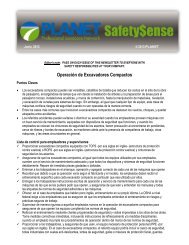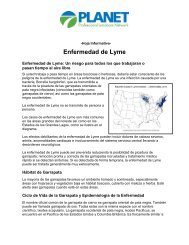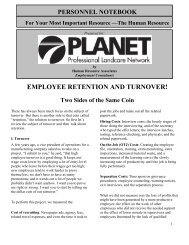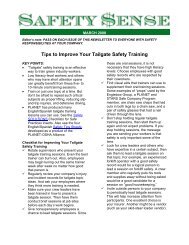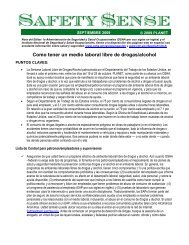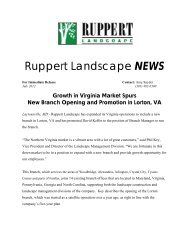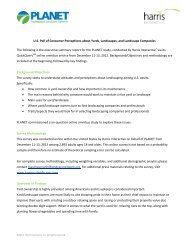Economic Impacts of the Green Industry in the - Urban Forest ...
Economic Impacts of the Green Industry in the - Urban Forest ...
Economic Impacts of the Green Industry in the - Urban Forest ...
You also want an ePaper? Increase the reach of your titles
YUMPU automatically turns print PDFs into web optimized ePapers that Google loves.
Executive Summary<br />
The environmental horticulture <strong>in</strong>dustry, also known as <strong>the</strong> “<strong>Green</strong> <strong>Industry</strong>”, is comprised <strong>of</strong> a variety <strong>of</strong><br />
bus<strong>in</strong>esses <strong>in</strong>volved <strong>in</strong> production, distribution and services associated with ornamental plants, landscape and<br />
garden supplies and equipment. Segments <strong>of</strong> <strong>the</strong> <strong>in</strong>dustry <strong>in</strong>clude wholesale nursery, greenhouse and sod growers,<br />
landscape architects, contractors and ma<strong>in</strong>tenance firms, retail garden centers, home centers and mass<br />
merchandisers with lawn and garden departments, and market<strong>in</strong>g <strong>in</strong>termediaries such as brokers, horticultural<br />
distribution centers, and re-wholesalers. In addition to <strong>the</strong>se commercial sectors, many state and local<br />
governments have significant urban forestry operations for management <strong>of</strong> parks, botanic gardens, and right-<strong>of</strong>ways<br />
that are an <strong>in</strong>tegral segment <strong>of</strong> community <strong>in</strong>frastructure. The <strong>Green</strong> <strong>Industry</strong> is l<strong>in</strong>ked to urban forestry by<br />
provid<strong>in</strong>g quality plant material and pr<strong>of</strong>essional personnel with specialized expertise for grow<strong>in</strong>g, ma<strong>in</strong>ta<strong>in</strong><strong>in</strong>g,<br />
and manag<strong>in</strong>g city trees.<br />
Environmental horticulture is one <strong>of</strong> <strong>the</strong> fastest grow<strong>in</strong>g segments <strong>of</strong> <strong>the</strong> nation’s agricultural economy, <strong>of</strong>ten<br />
experienc<strong>in</strong>g growth and expansion even dur<strong>in</strong>g recessionary periods. The nursery and greenhouse sector has<br />
experienced considerable growth <strong>in</strong> <strong>the</strong> last two decades, albeit slow<strong>in</strong>g somewhat <strong>in</strong> recent years. The landscape<br />
design, construction, and ma<strong>in</strong>tenance sector has also expanded due to strong economic conditions and robust<br />
build<strong>in</strong>g activity. Retail sales <strong>of</strong> horticultural goods have <strong>in</strong>creased for both <strong>in</strong>dependent and cha<strong>in</strong>-store type<br />
retailers, with considerable consolidation occurr<strong>in</strong>g due to <strong>the</strong> <strong>in</strong>creased presence <strong>of</strong> home centers and mass<br />
merchants <strong>in</strong> <strong>the</strong> lawn and garden marketplace. The outlook for <strong>the</strong> <strong>Green</strong> <strong>Industry</strong> is promis<strong>in</strong>g, yet <strong>the</strong>re are<br />
several challenges that will <strong>in</strong>crease competitive pressures.<br />
In view <strong>of</strong> its importance, numerous studies have been conducted to document <strong>the</strong> <strong>Green</strong> <strong>Industry</strong>’s economic<br />
impacts <strong>in</strong> <strong>in</strong>dividual states or regions, however, <strong>the</strong> present study represents <strong>the</strong> first attempt to evaluate it<br />
economic impacts for <strong>the</strong> entire United States, us<strong>in</strong>g data from previous studies toge<strong>the</strong>r with secondary <strong>in</strong>dustry<br />
statistics. A specific objective <strong>of</strong> <strong>the</strong> study was to evaluate <strong>the</strong> role, value and economic impact <strong>of</strong> forest tree<br />
species (woody ornamental trees) <strong>in</strong> <strong>the</strong> urban forestry environment.<br />
Nationwide estimates <strong>of</strong> <strong>the</strong> economic impacts <strong>of</strong> <strong>the</strong> <strong>Green</strong> <strong>Industry</strong> were derived from a variety <strong>of</strong> <strong>in</strong>formation<br />
sources, <strong>in</strong>clud<strong>in</strong>g <strong>in</strong>dustry statistics from <strong>the</strong> U.S. <strong>Economic</strong> Census and Census <strong>of</strong> Agriculture (2002), County<br />
Bus<strong>in</strong>ess Patterns, and primary surveys by horticulture economics researchers. <strong>Economic</strong> impacts for each state<br />
were computed us<strong>in</strong>g <strong>the</strong> Implan Pro s<strong>of</strong>tware to build regional <strong>in</strong>put-output models to derive economic<br />
multipliers that estimate <strong>the</strong> <strong>in</strong>direct effects <strong>of</strong> <strong>in</strong>dustry purchases and <strong>in</strong>duced effects <strong>of</strong> employee household<br />
spend<strong>in</strong>g, and also capture <strong>the</strong> effects <strong>of</strong> taxes and transfer payments.<br />
<strong>Economic</strong> impacts for <strong>the</strong> U.S. <strong>Green</strong> <strong>Industry</strong> <strong>in</strong> 2002 were estimated at $147.8 billion (Bn) <strong>in</strong> output, 1,964,339<br />
jobs, $95.1 Bn <strong>in</strong> value added, $64.3 Bn <strong>in</strong> labor <strong>in</strong>come, and $6.9 Bn <strong>in</strong> <strong>in</strong>direct bus<strong>in</strong>ess taxes, with <strong>the</strong>se values<br />
expressed <strong>in</strong> 2004 dollars (Table ES-1). For <strong>the</strong> production and manufactur<strong>in</strong>g sectors, <strong>in</strong>clud<strong>in</strong>g<br />
nurseries/greenhouses, lawn and garden equipment manufacturers, and greenhouse manufacturers, total output<br />
impacts were $34.6 Bn, employment impacts were 300,677 jobs, and value added impacts were $20.8 Bn. For <strong>the</strong><br />
horticultural services sectors <strong>of</strong> landscape services and landscape architects, total output impacts were $57.8 Bn,<br />
employment impacts were 753,557 jobs, and value added impacts were $39.0 Bn. For <strong>the</strong> wholesale/retail trade<br />
sectors, total output impacts were $55.5 Bn, employment impacts were 910,104 jobs, and value added impacts<br />
were $35.3 Bn. The largest <strong>in</strong>dividual sectors <strong>in</strong> terms <strong>of</strong> employment and value added impacts were landscap<strong>in</strong>g<br />
services (704,875 jobs, $35.6 Bn), lawn and garden stores (347,916 jobs, $14.8 Bn), nursery and greenhouses<br />
(261,408 jobs, $18.1 Bn), florists (200,451 jobs, $4.0 Bn), and build<strong>in</strong>g material supply stores (123,591 jobs, $6.5<br />
Bn). O<strong>the</strong>r sectors with large value added impacts were general merchandise stores ($4.0 Bn), landscape<br />
architects ($3.5 Bn), lawn and garden equipment manufacturers ($2.6 Bn), lawn and garden equipment<br />
wholesalers ($2.7 Bn), wholesale flower, nursery stock and florist supplies ($1.9 Bn), and food & beverage stores<br />
($1.4 Bn).<br />
<strong>Economic</strong> impact results are reported by state and region, as summarized <strong>in</strong> Table ES-2, Figures ES-1 and ES-2.<br />
Total value added impacts were largest <strong>in</strong> <strong>the</strong> Midwest region ($19.2 Bn), followed by <strong>the</strong> Pacific region ($18.4<br />
Bn), Nor<strong>the</strong>ast ($17.9 Bn), and Sou<strong>the</strong>ast ($13.5 Bn). The largest <strong>in</strong>dividual states <strong>in</strong> terms <strong>of</strong> value added<br />
1



